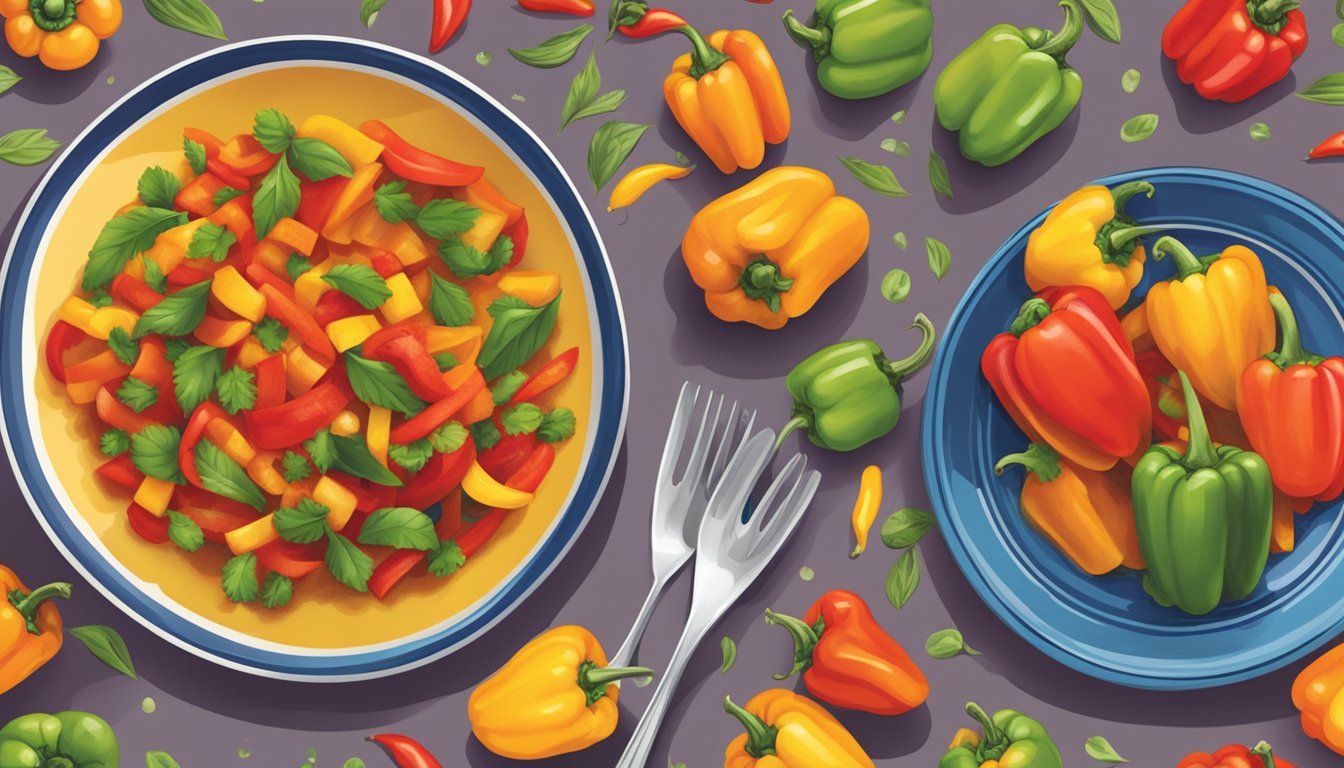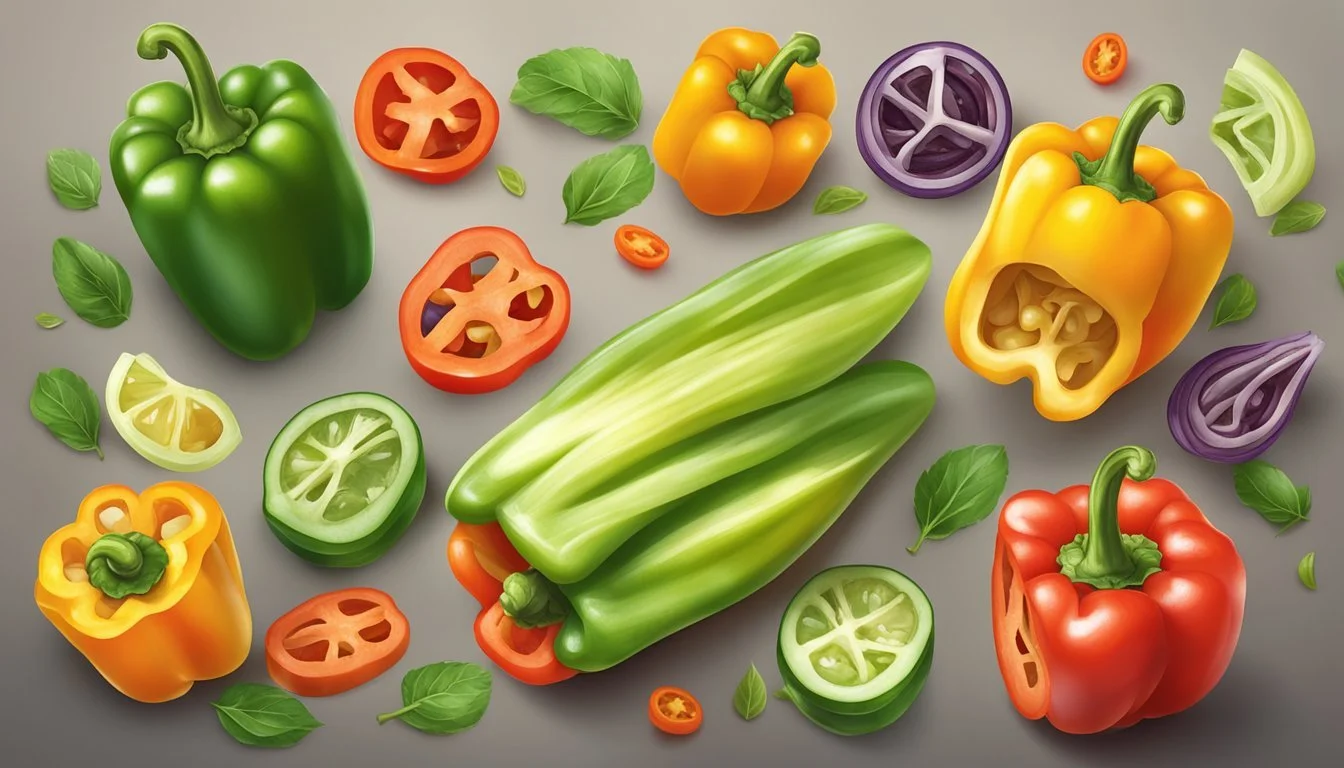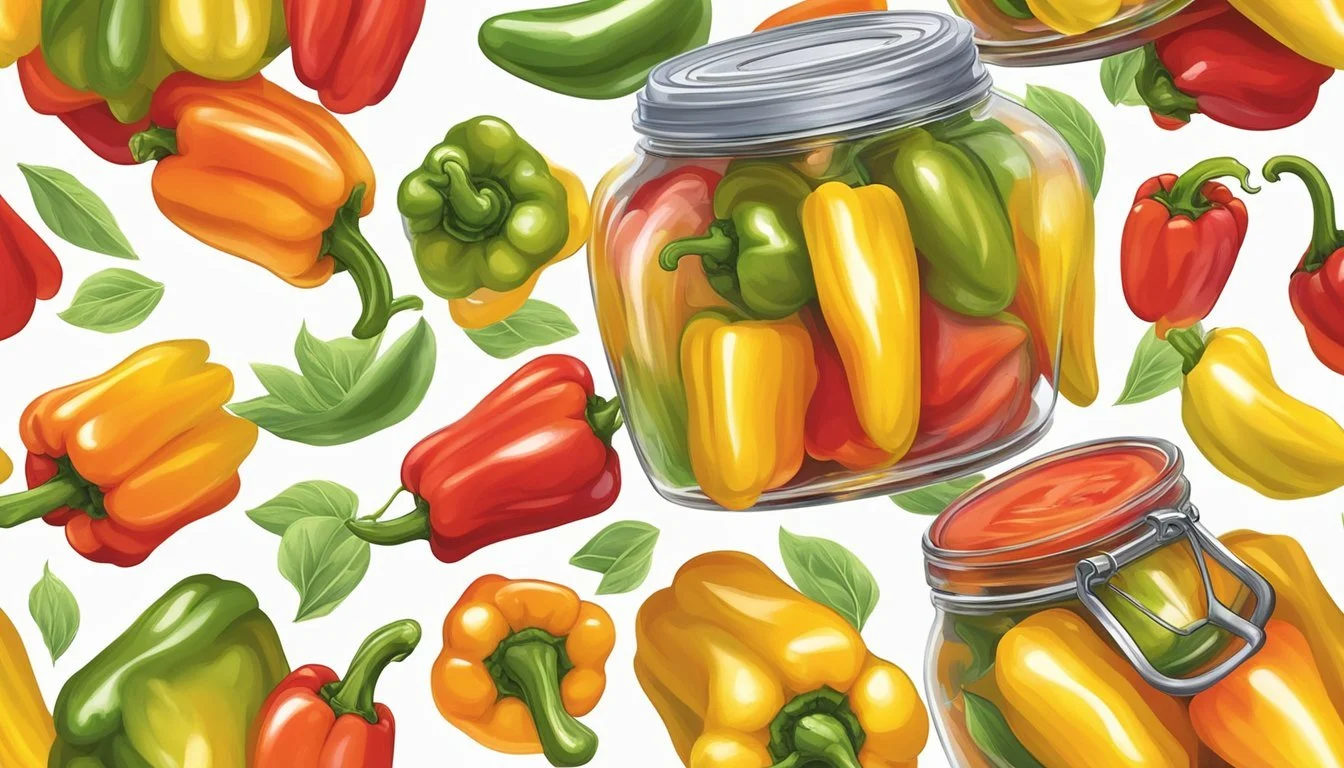Bell Pepper Top Relish
The Perfect Blend of Sweet and Tangy Flavors
Bell pepper relish is a vibrant condiment that brings a sweet and tangy flavor to a variety of dishes. Made from finely chopped bell peppers (What wine goes well with bell peppers?), onions, sugar, and vinegar, this relish is both a versatile and a flavorful addition to the pantry. Its bright colors and balanced taste complement the flavors of meats, cheeses, and sandwiches, making it a favorite among those who enjoy a touch of sweetness with a subtle tang.
The process of making bell pepper relish involves cooking the vegetables with sugar and vinegar, then allowing the mixture to thicken to the desired consistency. Some recipes may include spices such as mustard seeds or paprika to enhance the relish's flavor profile. Whether used as an accompaniment to meals or as a flavorful ingredient in recipes, bell pepper relish is a testament to the beauty of simple ingredients transforming into a delightful spread.
Basic Ingredients and Substitutions
When crafting Bell Pepper Top Relish, the choice of ingredients and possible substitutions can significantly affect the flavor and texture of the final product. This section explores the core ingredients and offers alternatives to customize the relish to taste preferences or availability.
Peppers and Their Varieties
Bell Pepper Top Relish primarily uses bell peppers for a sweet, mild flavor. For a relish with more heat, one can add jalapeños. Both red bell peppers and sweet peppers such as banana peppers offer a vibrant color and a milder taste. The peppers should be fresh and crisp to provide the best texture for the relish.
Choosing the Right Vinegar
Vinegar is essential for tanginess and preservation. Apple cider vinegar and cider vinegar are popular choices, offering a fruity contrast to the sweet peppers. The use of different vinegars like white or red wine vinegar can alter the flavor profile, adding a unique twist to the relish.
Sweetener Options
The choice of sweeteners ranges from granulated sugar to brown sugar, providing not only sweetness but also affecting the relish's color. Honey is a natural alternative for those who prefer less refined sweeteners, though it may not yield the same thickness as sugared versions.
Herbs and Spices for Flavor
The relish is seasoned with a blend of salt, typically kosher salt or sea salt, according to preference. Onion and garlic add depth and savoriness, while the use of mustard seeds or powder can give a mild heat and complexity. Additional herbs and spices may be introduced to create a unique taste profile.
Essential Equipment for Relish Making
In the process of making bell pepper relish, one requires specific tools to ensure proper preparation and preservation. Selecting the right jar and utilizing a food processor are critical elements to streamline the process and maintain the quality of the relish.
Selecting an Appropriate Jar
Choosing the correct jar is essential for the storage and curing of bell pepper relish. Glass jars are preferred for their non-reactive nature, ensuring the relish's flavor is preserved without alteration. The key is to select jars that can be sealed tightly to avoid contamination and to ensure long-term freshness.
Size: Opt for jars in a range of sizes depending on intended use. Smaller jars are ideal for personal consumption, while larger ones may be used for gifting or family servings.
Headspace: Leave about 1/2 inch of headspace at the top of the jar to allow for expansion and to create a vacuum seal during the canning process.
Lids: Use new lids each time to guarantee a secure seal. Reusing lids can result in a weak seal and potential spoilage.
Using a Food Processor
A food processor dramatically reduces the time and effort required to finely chop the bell peppers and other ingredients. Its consistent chopping ability produces a uniform texture throughout the relish.
Blade: A standard S-blade is effective for chopping vegetables to the desired size.
Capacity: Ensure the food processor's bowl is large enough to handle the volume of peppers and onions you plan to process.
Pulse Function: Utilize the pulse function to control the texture, preventing the vegetables from becoming overly pureed.
Relish Preparation
Preparing Bell Pepper Top Relish involves a few critical steps, starting with the proper preparation of the vegetables and ending with the condiment reaching its ideal consistency. At each stage, precision and attention to detail are paramount to ensure the relish's sweet and tangy flavor profile.
Cleaning and Chopping Vegetables
The vegetables, particularly peppers and onions, must be washed thoroughly to remove any dirt and pesticides. After drying, they should be minced or finely chopped to ensure even cooking and flavor distribution. Peppers are generally diced finely, making them small enough to blend well in the relish while maintaining a pleasant texture.
Bringing Ingredients to a Boil
Once the vegetables are prepared, they are combined with vinegar, sugar, and other seasonings, which can include mustard seeds or pickling salt. This mixture is then brought to a boil. It is crucial to stir continuously to dissolve the sugar and prevent any ingredients from sticking to the bottom of the pot.
Simmering to Perfection
After reaching a boil, the heat should be reduced, and the relish must be allowed to simmer. This stage could take 20-30 minutes, during which the mixture will gradually reduce and thicken. Stirring occasionally helps to promote even cooking. The relish is done when it coats the back of a spoon. At this point, it is ready to be jarred and cooled or served fresh.
Canning and Preserving
Making a flavorful bell pepper relish is only part of the process; understanding canning and preserving techniques ensures that the relish can be enjoyed safely for months. This section breaks down the essentials of making, canning, and storing bell pepper relish.
How to Make Bell Pepper Relish
To create bell pepper relish, one begins by finely chopping bell peppers and onions, then draining any excess moisture after rinsing. The relish base is cooked by combining the peppers with vinegar—often a mix of apple cider and white vinegar—sugar, and spices like mustard seeds. This mixture is then brought to a boil to meld the flavors before it’s ready to be preserved.
Understanding Canning Methods
Canning pepper relish involves filling sterilized jars with the cooked relish, leaving appropriate headspace, usually around ½ inch. Seal the jars with lids that have been simmered in water to sanitize and soften the sealing compound. The filled jars are then processed in a boiling water bath, which kills any remaining bacteria and creates a vacuum seal as they cool.
Ensuring Safe Storage
Once canned, pepper relish should be stored in a cool, dark place. Check that the lids have sealed properly with a concave appearance and no give when pressed. Properly sealed jars of relish can be safely stored for up to a year. After opening, keep the relish refrigerated and consume within a few weeks.
Serving and Pairing Suggestions
Bell pepper relish is a versatile condiment that enhances a variety of dishes with its sweet and tangy flavor profile. This section will provide specific suggestions for serving and pairing to help you make the most of this delightful condiment in your everyday meals.
Relish as a Condiment
Bell pepper relish shines when served as a condiment due to its ability to add a burst of flavor to common foods. It pairs exceptionally well with cheese, elevating the taste of a simple grilled cheese sandwich. Additionally, spreading relish over cream cheese on a cracker transforms it into a gourmet delight. The relish also serves as a vibrant topping for burgers, hot dogs, and sandwiches, offering a sweet and tangy contrast to the savory elements.
Creating the Perfect Appetizer
An appetizer's success hinges on its ability to tantalize the palate and set the stage for the upcoming meal. Incorporating bell pepper relish can achieve this effect effortlessly. For example, it can be served atop crostini with a slice of ham or smoked chicken for a touch of elegance. Alternatively, mix the relish into mini meatballs or savory pastry fillings for a flavor-packed start to any gathering.
Pairing with Proteins
The relish's vibrant flavors make it an ideal complement to various proteins. It pairs well with:
Chicken: A spoonful of relish can transform a grilled chicken breast into a culinary delight.
Pork: Serving relish alongside pork chops (What wine goes well with pork chops?) or tenderloin infuses the meal with a balanced zest.
Burgers: Top your favorite burger with a generous scoop of relish for an extra layer of taste.
Hot Dogs: Elevate a traditional hot dog with a dollop of relish to bring out a sweet and tangy twist.
Each protein pairing benefits from the relish's ability to complement and accentuate the natural flavors of the meat, ensuring a memorable and mouth-watering eating experience.
Nutritional Information
Bell Pepper Top Relish is a flavorful condiment that can elevate the taste experience of many dishes. This section provides insights into its nutritional profile, focusing on caloric content and dietary considerations to inform health-conscious consumers.
Caloric Content
Bell Pepper Top Relish typically contains a modest number of calories per serving. The calorie count can vary depending on the specific recipe and portion size. On average, a tablespoon serving size might range from 15 to 30 calories, stemming mainly from the natural sugars in bell peppers and any added sweeteners.
Dietary Considerations
Allergens: Generally, Bell Pepper Top Relish is free from common allergens such as nuts, gluten, dairy, and seafood, making it a safe option for individuals with these concerns.
Diet Types:
Vegan/Vegetarian: Most relishes, including this one, are suitable for vegan and vegetarian diets as they contain plant-based ingredients only.
Gluten-Free: Typically, it does not contain ingredients with gluten, although checking the recipe for any gluten-containing additives is advisable.
Low-Carb/Diabetes-Friendly: While bell peppers are low in carbohydrates, added sweeteners can increase the carb content, thus alternatives like stevia or erythritol might be used to make it appropriate for low-carb or diabetes-friendly diets.
Vitamins and Minerals: Bell peppers are a source of Vitamin A, Vitamin C, and various antioxidants, which can contribute to the overall nutritional value of the relish. However, the exact amounts will depend on the proportions used in the recipe.
Macronutrients:
Carbohydrates: Most of the carbohydrates come from the natural sugars in bell peppers and added sweeteners.
Proteins: This condiment contains minimal protein.
Fats: Bell Pepper Top Relish is typically low in fat, unless oil is used in the preparation process.
Customizing Your Relish
Creating the perfect bell pepper relish involves balancing flavors to meet one's individual taste. Whether one prefers a milder condiment or something with a kick, a relish can be tailored with a variety of ingredients.
Exploring Variations
One may choose to experiment with different types of peppers, such as the milder bell peppers or the incendiary ghost pepper, to fine-tune the flavor profile and heat level. Mustard, a classic addition, can be added as prepared mustard for a smoother taste or as mustard seeds for bursts of flavor. For added complexity, a sprinkle of celery seed introduces a subtle, earthy tone.
Adjusting Sweetness and Heat
The sweetness of a relish can be adjusted by choosing the right sweetener. Options include:
Sugar: Traditional and reliable, it offers consistency in sweetness.
Honey: It provides a natural and subtle flavor.
Brown Sugar Substitute: A lower-calorie option that still provides a rich taste, yet it may not thicken the relish as much.
For heat, one can add hot sauce to achieve an immediate spicy kick, or black pepper for a less intense but equally satisfying warmth. The amount of these ingredients should be altered to match one's individual heat tolerance.
Relish in Daily Meals
Bell pepper top relish is a versatile condiment that adds a sweet and tangy flavor to many daily meals. Its vibrant taste and texture can enhance an array of dishes across breakfast, lunch, and dinner.
Burger and Sandwich Enhancement
The addition of bell pepper relish to hamburgers and subs is transformative. By replacing traditional toppings such as ketchup, every bite achieves a balance of sweetness with an enjoyable tangy zest. A tablespoon of relish spread over a grilled cheese adds complexity to this simple comfort food.
Hamburgers: A spoonful on top or mixed into the patty
Subs: Layered with meats and cheeses
Grilled Cheese: Inside, alongside melted cheese
Breakfast Options with Relish
Bell pepper relish can elevate the first meal of the day. Mixing the relish into scrambled eggs or using it as a topping on a brat-infused omelet introduces a flavorful twist.
Scrambled Eggs: Mix in bell pepper relish before cooking
Omelets: Top with relish post-cooking for a fresh pepper bite
Adding Zest to Grilled Foods
As a stand-alone or complementary condiment, bell pepper relish brings life to grilled items such as bratwursts and hot dogs. The relish's sweetness and acidity cut through the savory juices of the meat, creating a well-rounded flavor profile.
Bratwursts/Hot Dogs: Dollop on top in lieu of or alongside mustard
Grilled Meats: Serve as an accompaniment for a flavorful contrast
Practical Tips and FAQs
This section provides practical advice on the preparation time frames, handling and safety concerns, and insights on gifting and sharing homemade bell pepper relish.
Preparation Time Frames
Prep Time: The initial preparation, which includes washing, deseeding, and dicing the peppers, typically takes about 15-20 minutes. Cook Time: Once prepped, the cook time for bell pepper relish is generally between 20 and 30 minutes, depending on the desired thickness. Total Time: From start to finish, one can expect the entire process to take between 35 to 50 minutes.
Handling and Safety Concerns
When making bell pepper relish, it's imperative to practice safe handling, especially when dealing with heat sources. One should never leave the cooking relish unattended to prevent any possibility of a burn. Additionally, ensure proper hygiene and sanitation when preparing ingredients to maintain safety and prevent foodborne illnesses.
Gifting and Sharing Relish
Bell pepper relish makes for an excellent gift, especially when presented in a sterilized jar with a decorative ribbon. Always include a label with the ingredients and expiration date for the recipient's convenience. When sharing, it's courteous to inform the receiver of the relish's sweet and tangy flavor profile, as well as any potential allergens, such as mustard seeds in the recipe.








